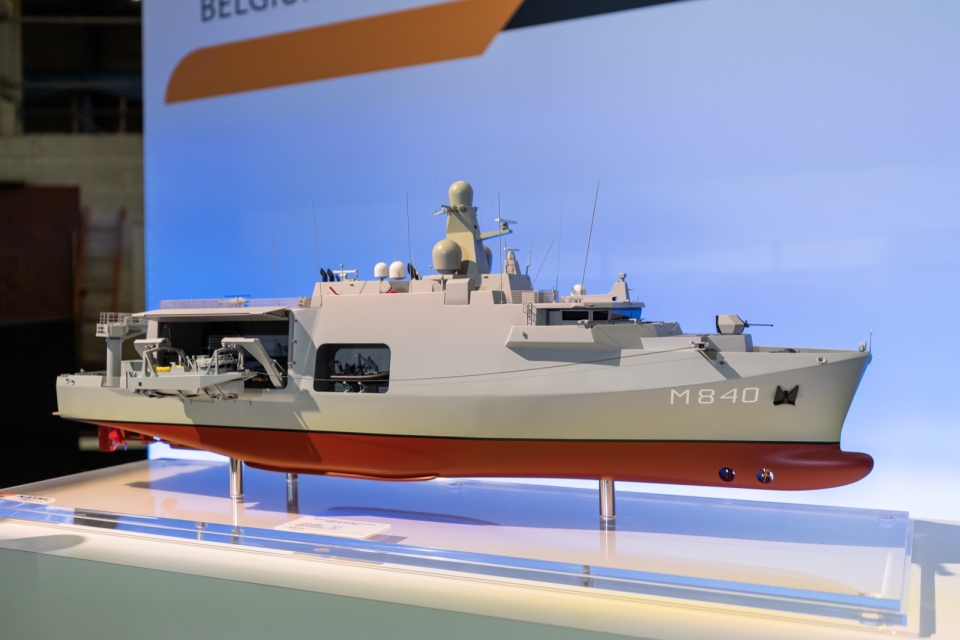The first new Mine Countermeasure Vessel for the Belgian navy, the M940 Oostende, was spotted on the water for the first time on 22 February. It involves a technical launch of the ship, the official launch is scheduled for 29 March.
The official launch in March will coincide with the keel laying of the third vessel in the series of twelve in total. The vessels are being built for the Belgian and Dutch navy. The contract for the series was awarded to Belgian Naval & Robotics, a subsidiary of France’s Naval Group and ECA Group. The Belgian vessels are built at shipyard Piriou at Concarneau in France. The Dutch vessels at Kership in Lorient, France.
The number of vessels are split evenly between the two navies. The six Belgian vessels will be named Oostende, Tournai, Brugge, Liège, Antwerpen and Rochefort, the Dutch: Vlissingen, Scheveningen, IJmuiden, Harlingen, Delfzijl and Schiedam.
Vlissingen may be launched in September
The current minehunters are nearing the end of their service lives and are therefore due for replacement. Construction of the Oostende began in November 2021, and it is expected to be delivered at the end of 2024.
The second vessel, which is being built for the Royal Netherlands Navy, the Vlissingen, is under construction and the Dutch Defence Materiel Organisation says it is possible this vessel will be launched as early as in September, a month ahead of the original schedule. Delivery of this vessel is planned for 2025.
The last vessel in the series, the Schiedam, is to be delivered in 2030.
Also read: Construction of first new Dutch Mine Countermeasure Vessel kicks off
Drones
The current generation of Mine Countermeasure vessels is still deployed weekly, but their successors can do the job more safely. They are equipped with unmanned and autonomous flying and sailing drones. These can be deployed on the water, above the water and under water. In this way, the ships and their crews no longer need to sail into an area where there may be sea mines and other explosives.
Commander of the Royal Netherlands Navy, Vice Admiral René Tas: ‘These Mine Countermeasure Vessels contribute to a future-proof mine-fighting operation and thus a safer future at sea for the Netherlands, Belgium and our NATO partners.’
Also read: ECA Group opens factory to manufacture drones for Belgian and Dutch Navies
Further cooperation with Belgium
The Netherlands and Belgium did not only seek cooperation in the procurement of the Mine Countermeasure Vessels. Both countries are also working on joint education, training and operation of the ships. The purchase of other equipment, such as the multi-purpose frigates, is also being done in agreement. The Netherlands has a leading role in this project, whereas the Belgians are in the lead for the minehunters, which are built at French Naval Group. ECA Group from Belgium supplies the drones.
The Mine Countermeasure Vessels have the following characteristics:
- Length: 82.6 m
- Width: 17 m
- Displacement: 2800 t
- Maximum speed: 15.3 knots
- Range: >3500 nautical miles
- Crew: 63 people
- Drone capabilities: ECA Group’s UMISOFT System, two unmanned surface vehicles (ECA Group’s Inspector 125), three autonomous underwater vehicles (A-18 equipped with ECA Group’s UMISAS 120 sonar), two towed sonars (T-18 equipped with ECA Group’s UMISAS 240 sonar), two Mine Identification & Destruction Systems (MIDS) systems (ECA Group’s Seascan et K-Ster C), two unmanned aerial vessels (UMS Skeldar’s V200), one ECA Group influence dredger integrating five CTM magnetic modules and one PATRIA acoustic module.
- Embarkation capacity: two SOLAS rigid hull inflatable boats of 7 m.
- Handling: two side gantries with floating cradle for surface drones and commando boats, a 15-t rear crane and a 3-t overhead crane.
Picture (top): A model of the first new Mine Countermeasure Vessel for the Dutch navy, the Vlissingen.
Also read: New minehunters’ launch and recovery system survives four-metre waves








